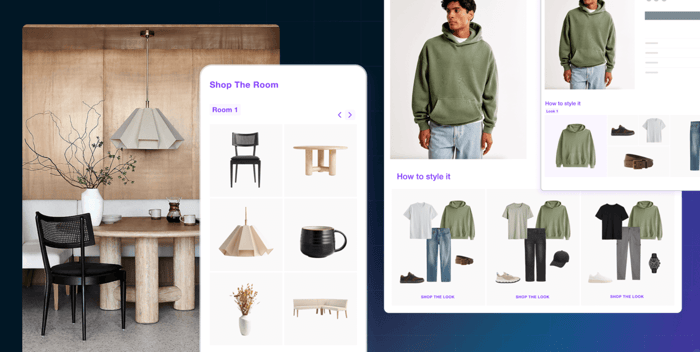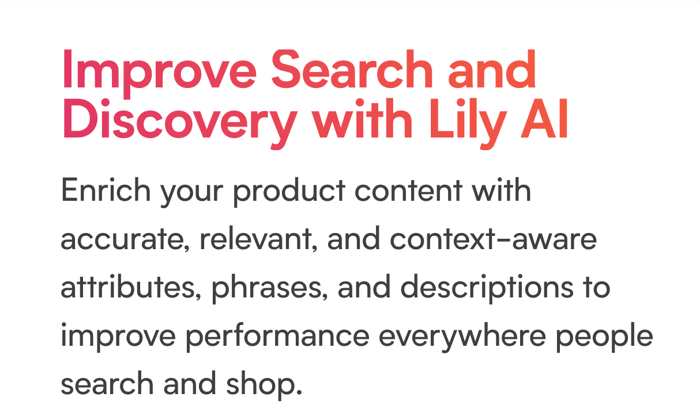Best 6 Fashn.ai Competitors & Alternatives in 2025
Table of Contents
AI is rapidly reshaping fashion retail, and platforms like Fashn.ai have emerged as game changers in product tagging, visual recommendations, and catalog intelligence. However, several Fashn.ai competitors now offer competitive or even more robust solutions.
If you're evaluating Fashn.ai alternatives in 2025, here are the top options to consider, each selected based on innovation, functionality and retail impact.
What is Fashn.ai?
Fashn.ai is an AI platform designed to streamline product data enrichment for fashion eCommerce brands. It uses computer vision and machine learning to automatically tag clothing and accessories, generate product descriptions and power personalized recommendations.
The platform is tailored for online retailers looking to improve catalog accuracy, search relevance, and conversion rates. Fashn.ai’s visual intelligence can recognize attributes such as style, color, pattern, sleeve length, and more, reducing manual work for merchandising teams.
It integrates easily with leading eCommerce platforms, PIM systems, and DAM tools, enabling fashion brands to scale their operations with clean, consistent, and enriched product data.

Fashn.ai Pricing
Fashn.ai offers tiered pricing based on catalog size, feature set, and API usage. While specific prices are not publicly listed, packages typically fall into three categories:
Starter Plan: Suitable for small catalogs (under 5,000 SKUs), with core tagging and description automation features.
Professional Plan: Includes advanced tagging customization, API access, and multi-language support.
Enterprise Plan: Offers full integration, ongoing model training, support for multiple catalogs or storefronts, and real-time enrichment capabilities.
Pricing is typically based on monthly usage or annual contracts, with enterprise packages negotiated based on volume and custom needs.
Why should you consider switching from Fashn.ai?
Limited Control Over Taxonomy
Fashn.ai relies primarily on pre-trained AI models for attribute detection and classification. While this enables fast and scalable tagging, it can present challenges for brands with unique or highly specialized taxonomies. For example, if you operate in niche verticals like luxury, adaptive clothing or streetwear, the standard attribute sets might not align with the terminology or hierarchy your merchandising and marketing teams use.
This limitation can lead to:
Misclassification of products.
Inconsistent attribute labeling across SKUs.
A need for significant manual review or post-processing.
Brands that require custom taxonomies—whether for internal organization, marketplace requirements, or advanced personalization—may find the default configuration of Fashn.ai too rigid or generic. Some platforms offer fine-grained control over taxonomy design and attribute training, which Fashn.ai currently lacks.
Lack of Built-In Market Insights
Unlike tools such as Edited or Lily AI, Fashn.ai does not integrate market analytics or consumer trend data. It focuses solely on visual product tagging and data enrichment, without embedding broader competitive intelligence, trend forecasting, or price benchmarking.
For fashion businesses that want to:
Align assortment planning with fast-moving trends.
Benchmark pricing and product positioning against competitors.
Anticipate shifts in consumer demand.
…this creates a gap. You'll either need to integrate Fashn.ai with external insight platforms or consider a more holistic solution that merges enrichment with strategic market data. The lack of context can make it harder to connect product attributes with real-time consumer behavior and demand.
No Emotional Tagging or Psychographic Data
Fashn.ai emphasizes objective, visual tagging—color, shape, pattern, garment type, etc.—but doesn’t incorporate emotional metadata or psychographic layers. In contrast, some AI enrichment tools now enable tagging that maps to buyer intent or mood-based categories (e.g., “confidence-boosting,” “romantic,” “professional”), which can greatly enhance personalization and marketing impact.
Without emotional tagging, Fashn.ai may limit:
Personalization algorithms that rely on shopper psychology.
Content strategies that target specific buying motivations.
Campaign segmentation based on mood, lifestyle, or persona.
As fashion becomes more experience-driven and emotionally charged, the ability to enrich products with intent-based metadata is becoming a key differentiator—one Fashn.ai doesn’t currently offer.
Limited Multilingual Capabilities
Fashn.ai performs reliably in English-language environments, but its support for multilingual tagging and enrichment is relatively basic. For global fashion brands operating in Europe, LATAM, or Asia-Pacific, this presents a scalability issue.
Consequences include:
SEO inefficiencies on non-English storefronts.
Misaligned product descriptions across regions.
Manual overhead for localization teams.
Some competitors now offer automatic localization and multilingual enrichment pipelines, supporting not just translation but cultural adaptation of taxonomy and attributes. In contrast, Fashn.ai may require significant customization or third-party tools to achieve similar results.
Best Fashn.ai competitors
1. Modelia
Modelia is quickly becoming a go-to platform for fashion retailers seeking advanced automation for product tagging, visual recommendations, and personalized discovery. Unlike traditional AI tagging tools, Modelia combines deep learning with retail psychology to drive real-time merchandising decisions.
Key Features:
AI-powered product tagging with fashion-specific taxonomy
Visual outfit builder & shoppable looks
Real-time personalization across devices
Multilingual attribute enrichment for global eCommerce
Why it stands out vs. Fashn.ai: Modelia offers a broader suite of styling automation and delivers faster time-to-value with pre-trained models tailored to fashion niches (fast fashion, luxury, etc.). Its onboarding is smoother, and UX tools are more refined.
Use Modelia to create your AI Models
2. Vue.ai
Vue.ai provides powerful automation for every layer of fashion retail—from intelligent cataloging to customer experience personalization. Large fashion brands appreciate its enterprise-level integrations and machine learning capabilities.
Key Features:
Automated catalog tagging
AI-based visual search
Dynamic personalization for fashion shoppers
Site merchandising automation
Comparison to Fashn.ai: Vue.ai rivals Fashn in functionality, with additional tools to automate large-scale retail operations.

3. Syte
Syte empowers fashion and home retailers with visual AI, helping shoppers find similar styles, colors, or patterns by uploading or clicking on images.
Key Features:
Visual search engine
Smart product discovery widgets
Hyper-personalized recommendations
AI filters for faster navigation
Fashn.ai vs Syte: Syte outperforms in visual discovery, with a product interface that appeals to DTC and mobile-first brands.

4. Edited
Edited isn’t a direct clone of Fashn.ai but serves as a strategic complement. Its platform delivers real-time pricing and trend data to inform product assortments and markdown strategies.
Key Features:
Market benchmarking
Trend forecasting
Product lifecycle analytics
Pricing recommendation engine
Use case as a Fashn.ai alternative: Combine with tagging tools to build a data-backed product launch or pricing roadmap.

5. Stylitics
Stylitics helps brands increase AOV by enabling “Shop the Look” functionality and curated bundles. It offers plug-and-play personalization for outfits without heavy engineering support.
Top Capabilities:
Outfit curation engine
Shoppable content widgets
Cross-selling automation
Scalable product bundling
Best for replacing: Fashn’s recommendation engine in UX-focused websites.

6. Lily AI
Lily AI transforms fashion product data by tagging items with emotional and contextual attributes. This aligns product descriptions and search with real consumer language.
Features Highlight:
NLP-based tagging
Emotional/intent data layering
Enhanced PDP and search performance
Flexible API for data ingestion
Vs. Fashn.ai: Stronger in customer intent modeling and marketing alignment.

Comparison Table
Platform | Best For | Visual AI | Tagging | Personalization | Trend Data |
|---|---|---|---|---|---|
Modelia | End-to-end AI for fashion UX | ✅ | ✅ | ✅ | ➖ |
Vue.ai | Retail process automation | ✅ | ✅ | ✅ | ➖ |
Syte | Visual product discovery | ✅ | ✅ | ✅ | ➖ |
Edited | Market intelligence & pricing | ➖ | ➖ | ➖ | ✅ |
Stylitics | Shoppable bundles & AOV growth | ✅ | ➖ | ✅ | ➖ |
Lily AI | Customer intent & PDP optimization | ➖ | ✅ | ✅ | ➖ |
Conclusion. Last thoughts on Fashn.ai competitors
Fashn.ai is a solid solution for automating fashion product tagging and enhancing catalog consistency, especially for English-speaking markets with standard taxonomy needs. However, as fashion eCommerce becomes more global and customer expectations shift toward hyper-personalized experiences, businesses may find that Fashn.ai’s capabilities are limited in scope.
If your brand requires greater taxonomy flexibility, multilingual support, or AI models aligned with emotional buying behavior, it may be time to explore other tools. Platforms like Modelia, Vue.ai, Lily AI, and Edited offer expanded functionality that can better support complex merchandising strategies, trend forecasting, and localization at scale.
Before committing to any solution, assess your internal workflows, internationalization goals, and marketing alignment to determine which platform can truly future-proof your catalog operations
How would you rate this article:
Related Articles
- The Art of Hand-Drawn Fashion Sketches in Modern Design
- Best Practices for Capturing High-Quality Mannequin Photos
- 10 Best AI Video Editing Tools for Streamlined Editing and Creation
- 10 Best AI Fashion Free Model Generators
- The Most Iconic Fashion Magazine Covers Ever
- Best 6 Fashn.ai Competitors & Alternatives in 2025
- The Best Autumn Outfit Ideas for This Season
- Top 5 AI Background Removal Tools for Effortless Photo Editing
- Best AI Clothing Design Software for Next-Level Fashion Design
- Top AI Tools Every Ecommerce Store Should Use
